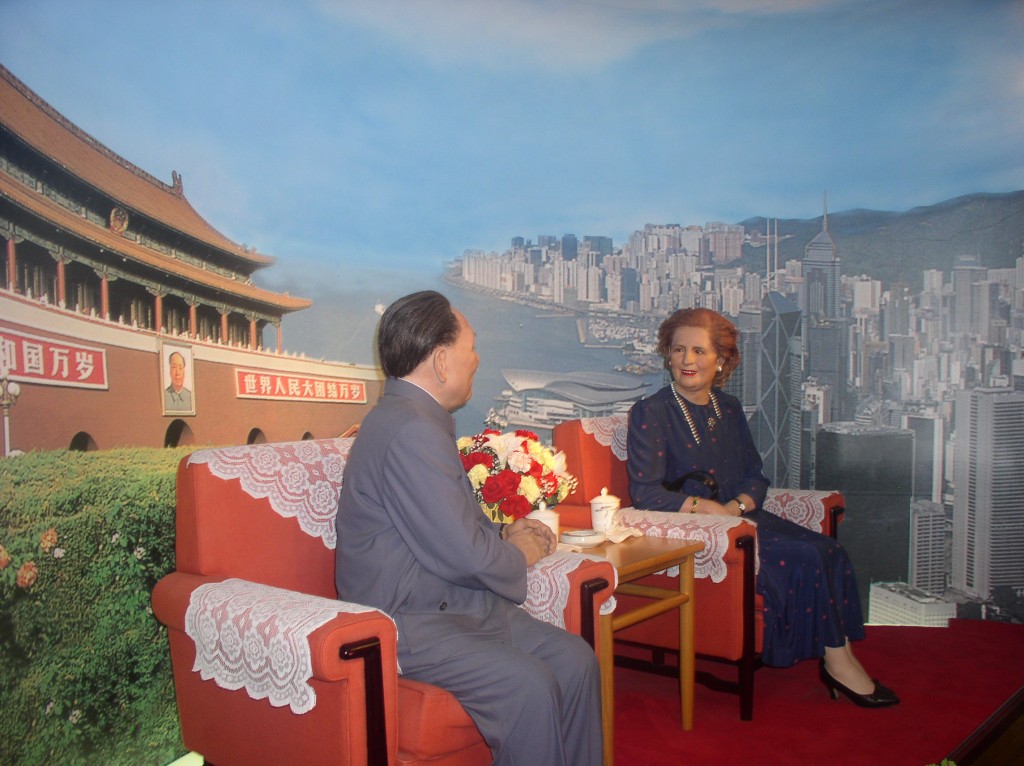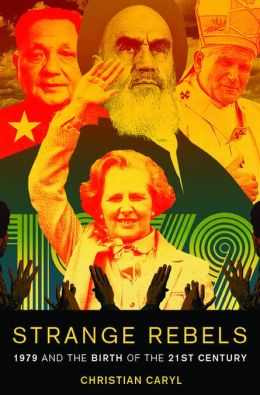Short Fuse Book Review: A Fascinating Tale of “Strange Rebels”
Author Christian Caryl ends Strange Rebels with the idea that “if the experiences of 1979 suggest one conclusion, it is that we should never underestimate the powers of reaction.”
Strange Rebels: 1979 and the Birth of the 21st Century by Christian Caryl. Basic Books, 432 pages, $28.99.
By Harvey Blume.
Near the end of Christian Caryl‘s eye-opening account of global change, the author makes a return trip to Shenzhen, a city on the Chinese mainland just north of Hong Kong. After taking the elevator to the observation deck on the 69th floor of the Diwang Mansion, the city’s tallest building at the time —he is careful to stipulate it might not hold that title for long—Caryl strolls through an historical exhibit until he is face to face with “a remarkable sight: Deng Xiaoping and Margaret Thatcher are having a chat. The two life size wax figures . . . sit in armchairs against a backdrop photomontage: Beijing’s Forbidden City behind Deng’s head, Hong Kong behind Thatcher’s. Two pots of tea sit on the table between them.”
A plaque dispels the mystery about this seemingly surreal tableau, which commemorates the 1984 agreement between Deng and Thatcher to return Hong Kong to Chinese rule. But for Caryl, the waxwork points to something deeper, including, to start with, the astonishing transformation of Shenzhen.
In 1979, Shenzhen was a sleepy village, folded into the “usual South China landscape.” A visitor who made it past “scowling border guards wearing uniforms adorned with the emblems of the People’s Republic of China” would be greeted to vistas of “rice paddies, worked by peasants and their water buffalo in the time-honored manner, and duck ponds.” By the time of Caryl’s visit, however, a few decades later, Shenzhen and the surrounding area housed “a larger manufacturing workforce than the entire United States.”
In the West, we think of Shenzhen, if at all, as the site where workers assemble Apple Ipods under, so it has been charged, atrocious conditions. Caryl makes no reference to these accusations, but he does supply historical context: Shenzhen’s status as manufacturing powerhouse stems directly from “reforms that Deng and his party comrades unleashed in 1979.” These, in turn, have been characterized as the “largest poverty-reduction program in human history.”
In 1979, Deng, recently returned from the punishment and exile that was his lot during the Cultural Revolution, began to relieve China from Mao’s crushing aversion to private property and economic initiative; in particular, he authorized Special Economic Zones, of which Shenzhen was one. 1979 was also the year Margaret Thatcher became England’s Prime Minister. It may seem at first that the year—1979—provides only the barest of links between Thatcher and Deng Xiaoping. Yet by the time readers encounter the Deng-Thatcher waxwork, Strange Rebels will likely have made them more than ready to entertain the notion that—without for a moment discounting irreducible differences between China and England—Margaret Thatcher might well be conceived of as a sort of English Deng Xiaoping and Deng Xiaoping as a sort of Chinese Thatcher.

Reconstruction of the important meeting between Deng Xiaoping and Margaret Thatcher in Beijing on September 24, 1984 with talks about the future of Hong Kong at the visitors platform of the Diwang Dasha in Shenzhen.
Thatcher came to power challenging the Laborite consensus that had gripped England since World War II and had begun, in the eyes of enough voters to ensure her a long tenure in office, to stifle the country. Did she inflict unnecessary suffering as she tried to free England from the dictates of labor unions and to encourage private initiative? Vehement debate about that, of course, continues. Caryl, however, is concerned to point out that Thatcher’s influence extended well beyond England. “Thatcherism,” he writes, became a “clearly identifiable global brand . . . the face of the market counterrevolution that swept the world,” with resonance in “places ranging form Latin America to Eastern Europe.”
That there was such a market counterrevolution is one of the themes of this book. Thatcher confronts labor unions and the welfare state tradition for control of England. Deng Xiaoping and his comrades confront Maoist dogma. But Caryl would invite others to a tea party thrown in honor of 1979. Ayatollah Khomeini would be on the guest list as well, 1979 being the year he returned from exile in Paris after the shah fled Teheran.
Some of the strongest passages in Strange Rebels pertain to the retooling of Islam by the likes of Khomeini. Blindsided and treated as nearly impotent by the seemingly irresistible forces of modernization and secularization, Khomeini and others taught Islam to assimilate aspects of Marxism, to appropriate the language of world revolution and to announce it had better answers “to the problems of modern life than Marxism or liberal democracy.”
Some of this transmutation of Islam happened in Paris, where Muslim leaders lived in exile. One, Ali Shariati, an influence on Khomeini, avidly read “Jean-Paul Sartre, Che Guevara, Mao and. . . General Giap” before returning to his favorite “mystic poets.” He engaged in polemics with Franz Fanon, leading him to conclude that Islam, “in fact, was the original path to a revolution that would end in a perfect, classless society unified in adoration of the One God. Marx, by comparison, was a pale Johnny-come-lately.” The jails of Teheran were another key transfer point. Communists and Shiite opponents of the shah, both tortured by his secret police, fought and debated there. Shiites came out of it with a grasp of Leninist discipline and organization.
With the hostage crisis, Khomeini presented Islamism as the aggressive force we now know it to be, complete with its signature weapon—suicide bombing, as employed by Iranian troops against Saddam Hussein’s invading armies in that inglorious war. How little the West was prepared to appreciate resurgent Islam can be seen in President Carter’s inability to describe Khomeini as anything other than “mentally ill.”
The guest list for Caryl’s tea party a la 1979 grows stranger still. Nor is Khomeini the only spiritual authority to be invited. Pope John Paul II would be welcome as well. His historic visit to Poland in 1979 served notice on Communist rule, even if it did so without wavering from a policy of strict nonviolence. Caryl suggests that the nonviolence marking the Fall of Communism, a decade later, owed much to the lasting influence of John Paul’s teaching.
Of course, when Communism fell, it had been weakened not only by the Polish Pope but by wounds on the world battlefield from which it never recovered. In 1979 the Red Army began its invasion of Afghanistan. Caryl writes, “Very few people in the international elite suspected that Islam was capable of posing a fundamental challenge to the global order—and certainly not in a place as backward and marginal as Afghanistan.” The defeat of Soviet forces in Afghanistan meant they could not, with anything like the old Stalinist aplomb, be deployed to crush the revolts against Communist rule that broke out in Eastern Europe in 1989.
This tea party a la 1979 might not last very long or arrive at anything like consensus. The guests are too disparate. They are united, all of them, only by representing forces that had been deemed outdated, exhausted, passé. It is tempting to write them off as reactionaries. Caryl would not object to the term. On the contrary, he concludes that “if the experiences of 1979 suggest one conclusion, it is that we should never underestimate the powers of reaction.”
With its sweep and intelligence, Strange Rebels is not a book readers are likely to forget.


